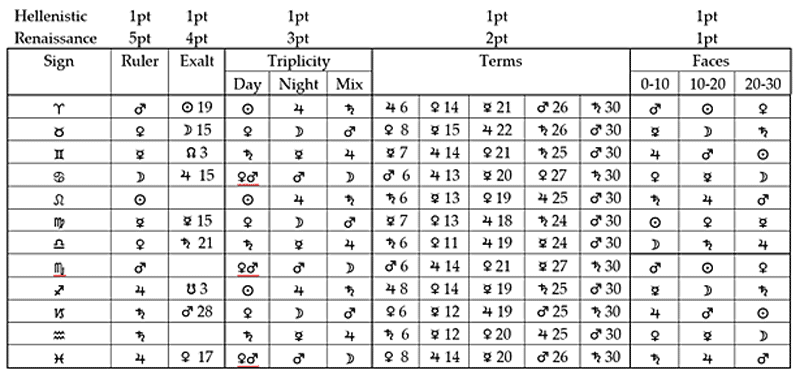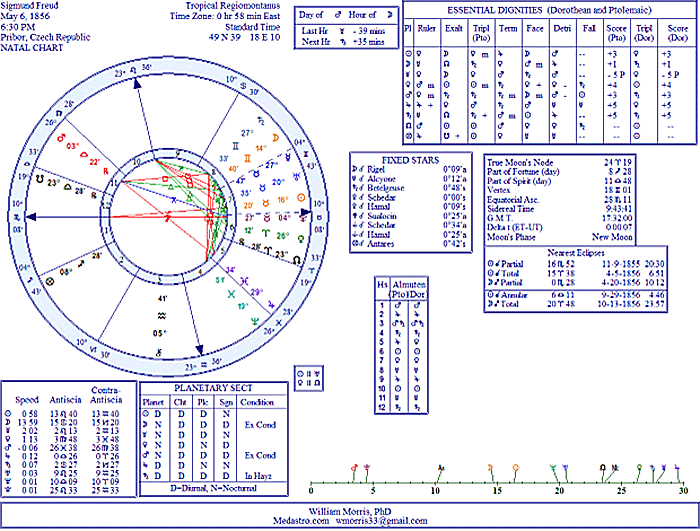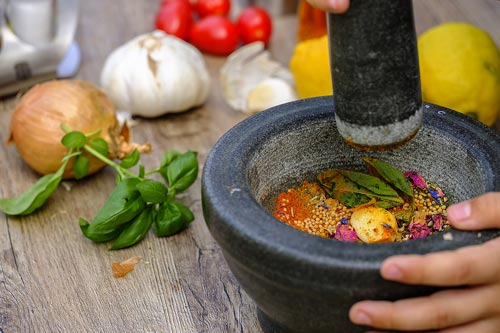Ring the bells that still can ring
Forget your perfect offering
There is a crack, a crack in everything
That's how the light gets in
~ Leonard Cohen, from the song Anthem on the album The Future, 1992
Medical assessments take place relative to location, process, and severity. The body and Soul are fundamental for locating the disease and its origins, while the humours provide the most finely nuanced descriptions of the process for a terrain-centered view.
My approach is to identify the most extreme presentation of dignity or debility. That condition with the greatest difference from the center can make the most significant difference in remediation. This method allows one to identify the most sensitive points within the system (Bateson, 1972), for which I use the Table of Dignities (Table 6, below) to provide clues as to their location.
Thus, the table of dignities is often employed to seek a single representative for a fulcrum in treatment. I propose including all five dignities and their planetary rulers in a complexity model to develop the herbal formula or culinary dish.
The nativity portends which conditions will arise in the course of life, it has better use for health conditions based on genetics and constitutional conditions. Therefore, I am not using the Almuten of the radix for passing health conditions, rather, the decumbiture, diagnostic report horary, solar return, appropriate critical days, and consultation charts may prove more salient for acquired and transient health conditions.
I use the planet that rules the area of life, requiring some form of transformation.[18] It may be a house ruler, a planet ruler, or another sky object related to health.
For example, profections, transits, and changes of timelords under the influence of Saturn can bring about various forms of stagnation. Stelliums also bring about stagnation. Evaluate the conditions of the planets ruling such stelliums for developing a treatment strategy.[19]
The primary treatment principle for stagnation is transformation, specifically of the elements and consequent humours. But the stagnation may be due to deficiencies or excesses.
I evaluate the soul condition with the birth horoscope. All other chart assessments, whether solar return, decumbiture, or the consultation chart, reflect events, rather than the soul characteristics of the native. The same applies to transits, profections, planetary lord systems, and directions. They all make statements about the events which the soul experiences.

Please note the Hellenistic count is different from the later Rennaissance method. The better part of wisdom would have a practitioner assessing both perspectives for purposes of tie breaking.
Look at the actual table of dignities (above) rather than a report from software. The findings may be different. Having the table readily available is also helpful for those points not included in the computer-generated table. More importantly, all components of a dignity row, including the domicile, exaltation, triplicity, bounds, or face lords, are used to construct a dish or formula. [20], [21] I use all three triplicity rulers for corresponding life stages per al Andarzagar, as quoted by Sahl and others (Dykes, 2019). I also use single points as in the Hellenistic and Babylonian approaches. I reserve the rest of the debate on technicalities in the table for another time.
Dosage and Recipe Proportions
Now is an excellent time to enter into the conversation about dosage. The smallest dose can sometimes make the most significant difference. Coherence is what I am after. And in this instance the points that a planet receives along the row of dignities using a single point system provides a connection to proportions of flavour in dishes and herbal formulas. To rephrase this important idea, using the table of dignities as a lens, I want to match all planetary influences over the essential dignity for a given point along the ecliptic. If there are recurrences of a given planet in that frame, give its remedies a larger dose.[22]
The Han Dynasty 'saint of medicine' Zhang Zhongjing used formula proportions that matched the Fibonacci series.[23] Thus a formula is written in portions, often using the number 3,6,9 in a three base system. The dominant planet in the dignity row is selected to explore the quantity, flavour, tropism, and function of the herbal agent selected, presuming adequate case information and relevance to the client's experience.[24]
For soul-level treatments, 'spirit doses' are good. These are often in the form of drop doses given in an appropriate number relative to the planetary influences as desired. For a Fibonacci series-based recipe, use three to five numbers, and distribute the dosage of herbs into the formula accordingly. Case Vignette
Freud makes a choice example chart. His three-fold structure of the Psyche in the form of the id, ego, and superego tightly mirrors the tripartite Soul of the early Greeks.[25]
In the European tradition, the Sun competes with the Almuten of the Ascendant to indicate the Soul.
I am inclined to identify Mercury as the distinct feature of his contributions to the world. For Sigmund, the Mercury is weak, yet he is one of the most towering intellects in the western world. As for the Peregrine Mercury, he had a syncretic mind that operated differently from the norm (see Image 2). With a negative 5 and perigrine score for Mercury on the table, I wish to supplement. Referring to the Table of the Five Flavours of Soul Flavours (Table 5, Part 2), the bitter taste supplements Mercury and the salty taste transforms. A bitter salad with sea weeds provides both a supplementing and transforming virtue.

Contrary to Montulmo, I use only the five visible planets of Mars, Venus, Jupiter, Saturn, and Mercury. The luminaries operate at a dimension that addresses generalities more than the particulars of the Soul. Such detail reflects within each of the organs associated with the five visible planets. The assignments to the elements and the organs derive from the Yellow Emperor's Classic, allowing for the application of the five Souls concept in Chinese medical practice.
I use transforming flavours to mobilize the organ and its affiliated soul-level resonance. The level of dignity is not necessarily positive, nor does a low number suggest something negative. There is more energy and an increased ability to act. Aspiring to a social average between the planets, I reduce those with high numbers and supplement those with low numbers.
Just as with medicinal herbs, there are specific actions that weave with the general principles. Sour eliminates what can be called 'counterflow' where bodily functions go opposite the normal physiology, such as nausea, vomiting, and cough in the upward direction. Or downward, such as leaking urine, stool, or reproductive fluids. The bitter flavour eliminates vexation. The aromatic flavour moves stagnation. The salty flavour dissolves accumulations, and the sweet taste eliminates dryness.
| Flavours | Bitter | Sour | Salty | Aromatic | Sweet |
|---|---|---|---|---|---|
| Sour | Gallium | Schizandra | Umeboshi | Agrimonia | Crataegus |
| Bitter | Berberis | Sanguisorba | Tree peony | Xanthoxylum | Astragalus |
| Salty | Tree peony | Citrus peel | Sea Weed | Elecampane | Rhubarb |
| Aromatic | Achillea | Agrimonia | Elecampane | Cardamon | Cinnamon |
| Sweet | Althea | Crataegus | Rhubarb | Cinnamon | Glycyrrhizae |
In Summary
We have journeyed from the Hellenistic/Han dynasty to the modern period. Hopefully, these excursions through the concepts of the Soul withal have brought about some consideration of the historical developments. We also explored using the table of dignities to understand the five Souls of Chinese medicine based on the five visible planets as they appear within each dignity column. We also addressed the matter of remediation through the use of flavours, as they can appear in foods and herbal formulas. These Concepts remain nascent and are being applied and verified in clinics with students and peers. Further development is most certainly in order.
Go to Part 1: Soul Flavours: Essential Dignity as a Tool for Remediation
Go to Part 2: Soul Flavours: Astrology and the Soul
Gratitude
The author would like to express the deepest gratitude to Scott Silverman for his editorial assistance, while taking full responsibility for any and all errors of grammar, linguistics, and rationale. Further appreciation goes to my teacher Lee Lehmann who encouraged me to embark on this paper, I hope that my departures from tradition are not disturbing and that there is sufficient explanation.
William Morris, DAOM PhD
William Morris is a medical astrologer who gave his first consultation in 1977. He is practicing in the Kootenay Lake District of British Columbia. His background includes a master's degree in medical education from the University of Southern California, a clinical Doctorate and Acupuncture and Oriental Medicine, and a PhD in transformative inquiry focused on practice-based knowing. Will has published books on TCM and astrology and has 43 years of clinical experience using astrology as a feature of practice. During the 1990s he focused his practice on the methods of Lilly and Culpeper with 40 patients a week. He also used sidereal, cosmobiology, and Jyotish methods during that period. His work is a creole blend of music, astrology, medicine, and magic.
Endnotes for Part 3
[18] This can be evaluated by taking the house cusp for a given body part. This technique requires a quadrant-based house system. This highlights house system selection which should be driven by the needs of inquiry rather than scholarly bias or 'practice habit.’
[19] In my experience, stelliums are signatures of stagnation of which there are six: food, fluid, vitality, blood, cold, and heat. Of the modes, fixed signs are most prone to stagnation, while cardinal signs, as a reactive force, can experience more intense pathologies when stagnations do occur.
[20] The Hellenistic point system is one per column of dignity. The later Medieval and Renaissance point system is ranked 5-4-3-2-1. I look at both.
[21] This inclusive model is different from the Aristotelian logic of numerical dominance.
[22] This approach is a departure from the traditional approach of locating the planet with the largest number of points in a row or set of rows. Rather, I include all data points in deference to quantum weather mechanics whereby a butterfly flapping its wings in Beijing seeds a tornado in Connecticut.
[23] The Fibonacci series is a set of numbers in which each number is the sum of the two numbers that come before it in the series, for example, 0, 1, 1, 2, 3, 5, 8 .. This describes the natural unfolding of biological systems and was first seen by Fibonacci, observing rabbit population growth.
[24] I situate medical astrology into the 'field of signs’ that include visual observation of the complexion and tongue as well as other features of the medical history and physical examination. Thus, the astrodata do not replace standards of practice but rather enhance them.
[25] Freud’s psychoanalytic theory gives id to the lunar primitive and instinctual part of the mind. The solar super-ego operates as a moral conscience, and the ego mediates between the desires of the id and the super-ego in a mercurial fashion.
References
Aristotle. (2001). De Anima (On The Soul) The Basic Works of Aristotle: Random House (ModernLibrary.com).
Cohen, L. (1992). Anthem. On The Future.
Culpeper, N. (1655). Astrological Judgment of Disease from the Decumbiture of the Sick: Ascella.
David, A. P. (2012). Homer and the Soul. Retrieved from https://classicalwisdom.com/people/poets/homer-soul/
Dykes, B. N. (2019). The Astrology of Sahl B. Bishr Volume I: Principles Elections, Questions, Nativities (B. N. Dykes, Trans.): Cazimi Press.
Ficino, M., Kaske, C. V., & Clark, J. R. (1989). Marsilio Ficino, Three Books on Life: A Critical Edition and Translation with Introduction and Notes: MRTS.
Ficinus, M. (1702/2011). Liber de Arte Chemica Geneva. In E. Ashmole (Ed.), Theatrum Chemicum, Vol 2. London/Seattle: Ouroborous.
Floyer, J. (1707). Physician's Pulse Watch. London.
Greenbaum, D. G. (2016). The Daimon in Hellenistic Astrology: Origins and Influence. Boston: Brill.
Hartman, F. (1887, reprint ed. 1985). The Life of Paracelsus and the Substance of His Teachings. San Diego: Wizard's Bookshelf.
Heshang Gong, L. T. (2015). The Heshang Gong Commentary on Lao Zi's Dao De JIng (D. G. Reid, Trans.): Center Ring Publishing
Larre, C., & Rochat de la Vallée, E. (1991). The Heart: in Ling Shu, chapter 8. Cambridge: Monkey Press.
Lorenz, H. (2009). Ancient Theories of Soul. In E. N. Zalta (Ed.), Stanford Encyclopedia of Philosophy.
Montuori, A. (2005). Gregory Bateson and the Promise of Transdisciplinarity. Cybernetics and Human Knowing, 12(1-2), 147-158.
Morris, W. (2015). Transformation: Treating Trauma with Acupuncture and Herbs. Austin, TX: 33 Publishing.
Morris, W. (2018). Cycles in Medical Astrology: 33 Publishing.
Pankenier, D. W. (2014). Did Babylonian Astrology Influence Early Chinese Astral Prognostocation "Xing Zhan Shu" "星占術"? Early China (37), 1-13.
Sachau, D. E. C. (1988). Alberuni's India: An Account of the Religion, Philosophy, Literature, Geography, Chronology, Astronomy, Customs Laws, and Astrology of India About A.D. 1030 Trubener's Oriental Series(,).
Salmon, W. (1671). Synopsis Medicinae or A Compendium of Astrological, Galenical, and Chymical Physick. London: W. Godbid, for Richard Jones, Bookseller at the Golden Lion in Little Britain.
Saunders, R. (1677). The Astrological Practice of Physick: Deduced from the Position og the Heavens at the Decumbiture of the Sick Person. London: Thomas Sawbridge.
Unschuld, P. U. (2016). Huang Di Nei Jing Ling Shu: University of California Press.
Valens, V. (1996). The Anthology Book IV (R. Schmidt, Trans.). Berekely Springs, WV: The Golden Hind Press.
Voss, A. (1992). Magic, astrology and music: the background to Marsilio Ficino's astrological music therapy and his role as a Renaissance magus. City University London.
Wu NL, W. A. T. (1996). Yellow Emperor's Canon of Internal Medicine. Shandong: China Science and Technology Press.
Yang, J. C., & Morris, W. (2007). Shen Harmony: The normal mental condition in Chinese Medicine. Acupuncture Today, June.
Zhang, H. (2015). Introduction on Fu Xing Jue: Passages from Tang Ye Jing. Open Access Library Journal, 3(8), 1-7.

